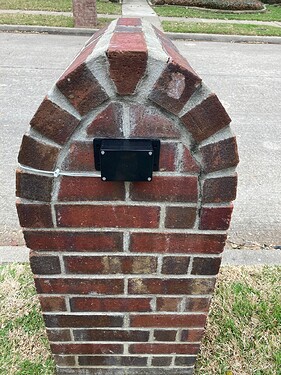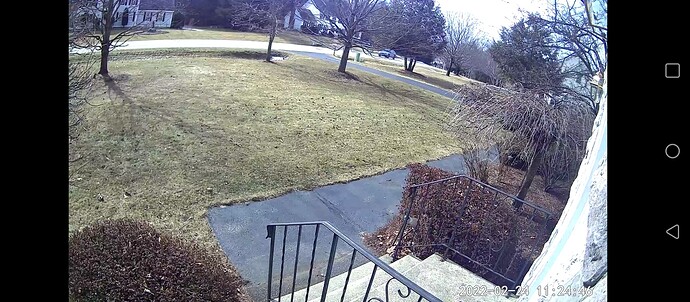Definitely looking forward to Z-Wave LR! My mailbox is across the street and about 2 houses down. I thought about giving one of these sensors a try to the mailbox, but I have no idea if it would reach or not. Given the recent info about LR, I think I'm just going to wait it out until some LR contact sensors are released and see how that works. From the sounds of it, I think it will work just fine.
Inside the box would hurt the signal a lot, but outside of the box would be no issue for LR (I expect).
I can get my outdoor sensors to read over a mile away with LoRa.
Yeah I'm hoping Ecolink (or another manufacturer) keeps the same design where you have terminals to connect an external sensor. I would then just stick the sensor under the mailbox since it is metal. I have about 150ft from mailbox to hub (according to google maps), so I don't see an issue with LR. The corner of my neighbors house covers it slightly as well, so I don't know if regular Z-Wave Plus would work in this situation.
I ended up with using a plastic junction box to hold the contact sensor (https://www.amazon.com/gp/product/B07TYNYW1S/). It was just about the right size. Let's hope this solution lasts through the Texas summer!
That's quite the sturdy mailbox! And it doesn't see any snow plows!
Maybe it’s a Texas thing but almost every mailbox here seems to be like this! ![]()
(mostly) 
Hey Everyone,
I am trying to add a zwave sensor to our mailbox to let us know when the mail is here, but I am running into a few issues:
-
Since a lot of the Ecolink and GoControl zwave contact sensors on Amazon are currently unavailable, I went ahead and purchased an Ecolink TILT-ZWAVE2-ECO Garage Door Tilt Sensor with external dry contacts. I can get sensor to connect to HE, but only at close proximity to the hub. Does anyone know if this sensor can be paired farther away from the hub, say, next to an already included mains-powered zwave device?
-
Another issue is that this sensor will only work with the normally closed magnetic reed switch when the sensor is in the "garage door open" orientation. I may have to remove the tilt sensor circuit board component if I need to mount this vertically. Has anyone used this type of sensor in an automation that wasn't for a garage door application?
-
The range for this particular sensor is 100 feet (30 meters). The mailbox is roughly 150 feet (46 meters) from the nearest outlet/wall switch, but they are in the inside of the house through drywall, insulation, and vinyl siding. With that said, I may be doomed from the start; but is there a zwave sensor available that can work at longer distances? Or, is there some sort of outdoor zwave repeater or zwave smart plug (that also functions as a repeater) I can plug into an exterior receptacle to help with this? Is there such a device that works on battery that I could mount to a post between the house and the mailbox to extend, bounce, or relay a signal between the two?
Any help, suggestions, or opinions would be greatly appreciated!
I too wanted to monitor my mailbox and I have tried contact sensors and tilt sensors, etc... but I could never make it dependable. And like the OP, I too have a metal mailbox some distance from the house, and I even put repeaters in my garage to help the distance, but I just simply couldn't get it reliable. So, I went OVER-KILL to finally get a solution that worked reliably. Using a dremel, I cut a square hole in the back of mailbox and attached an outdoor battery-powered Blink camera to the back of the mailbox. The camera shows the inside of the mailbox but the back of the camera sticks out the back which picks up my WiFi. Using the Alexa app, when the mailbox opens it detects that motion and triggers a virtual switch. The added bonus of this solution, on my panel in the house, not only does it alert me that the mailbox door has been open/closed, but I could also take a quick look inside remotely and see if packages were placed inside as well that I might be waiting for.
Sorry in advance, this is a long post.
Interesting solution with the camera. I too have a metal mailbox but it is imbedded into a planter/flower box, so no access. Being a metal mailbox, and not wanting to place a sensor or battery pack on the outside of the box, I utilized a very small wireless door sensor made by DSC to connect with my security system (also DSC). Battery life is supposed to be approximately 3-5 years (though I’m not sold on the 5 years lol). The batteries have been good for at least 3 years though. Because this is made as a wireless sensor on my security system, the range is very good.
I have my security system linked with HE via the Envisalink integration and the mailbox sensor is programmed in DSC to be a 24 hour sensor (but not one that alarms the security siren, as that would cause obvious problems). HE picks up the status (open or closed) via the Envisalink integration.
I also have the mailbox monitored by my security camera system, which is connected to the Camect system for object recognition. Camect (which also runs completely locally and is not cloud dependent), takes the video from my Amcrest 4K cameras, and its AI can reliably discriminate between various objects (such as people, trucks, cars, various animals etc). By integrating Camect with HE through the Camect Connect HE third party app by BrianWilson, object recognition attributes can be detected in HE. This is really helpful especially since Camect can even distinguish between USPS, UPS, Amazon, FedEx and DHL vehicles based on logo recognition.
This way, I get a notification from a Rule in HE that the mail has been delivered only when the attribute is “USPS” truck AND the mailbox is opened at the same time. BTW, I also use this to announce when an Amazon delivery is made to a particular door (front or back entry) and my announcements can discriminate between delivery companies as well as noted above.
The only thing that was a little bit of a hassle originally with the WAF was that if the mailbox door was closed too rapidly (basically slamming it shut like you would normally do), because the mailbox is metal, it acts as a Faraday cage and blocks the “closing” signal.
This actually turns out to be an advantage: When the mail is delivered, if the mailman closes the door too rapidly, then the mailbox reports as “open” and a voice announcement is made every two minutes that the mail has been delivered and that mailbox door has been left open (hopefully prompting someone in the house to check on the mailbox). I just had to show the wife to close the mailbox door with a very slight (1/2 sec or so) pause right before the door was completely closed so that the magnet would close the reed switch and the RF signal had an “out” to reach the receiver, cancelling the “mailbox left open” announcement (voice announcements at this time are made through Alexa). The reason this is good is that if anyone other than someone “in the know” accesses the mailbox, then closes it in the usually manner without the pause, then an announcement is made that “someone is accessing the mailbox, please make sure this is authorized”.
Another sensor that can be used that will actually send through the metal and dirt (I tested it and my mailbox is about 30-40 feet from my front door) is a LoRa type sensor. They have considerable range (up to 1/4 mile unobstructed according to the manufacturer). The only downside is that currently the brand I use (YoLink) requires a small hub (a little smaller than the Hubitat or Lutron hub) and does not have an open API to interface directly with HE, so the link has to be made through YoLink’s hub which can be accessed through Alexa, making it cloud based. I do understand that someone in the forums is trying to get Hubitat to work directly with the YoLink API but I’m not sure how far along they are with this. I use the YoLink water sensors and the Bulldog Valve Controller to shut off water to the house in the event of a leak due to the incredible range and reliability of their implementation of the LoRa system (however, their implementation is not the standardized LoRa so is proprietary, hence the need to get access to the API so that it can be made 100% local).
I suppose I can better deal with mailbox security issues by using a locking mailbox, but changing out my mailbox would involve excavating the planter box, breaking out the mailbox, installing a new locking mailbox, then repairing the stucco planter box, repainting, and replanting all the flowers, etc. (I am too lazy for that and luckily we live in a neighborhood that has not had problems with mail theft…knock on wood….and the wife works from home).
Again, sorry for the long post. I am by no means a “tech” guy and consider myself a noob (I have only been using Hubitat for about 1 1/2 years), but I wanted to contribute as I have gotten so much help from this community. Hope someone finds this helpful.
i use smartthings contact sensors and also put a zigbee repeater/switch in an outdoor outlet box .. it is small and fits in the box..
this is the switch i use
https://www.amazon.com/gp/product/B08P89M8P9/ref=ppx_yo_dt_b_search_asin_title?ie=UTF8&psc=1
Also as you can see here the mailbox.is metal and quite a good.distance from the house
All,
I was able to get the TILT-ZWAVE2-ECO Garage Door Tilt Sensor to work, but I had several obstacles to overcome though. For starters, since I wanted to mount the sensor vertically behind the mailbox on the mailbox post, I had to de-solder and remove the tilt sensor switch component on the circuit board since it would always show the mailbox as "closed."
Next, the other issue I had was a corrupt Z-Wave network that was causing routing issues and limited the distance for the sensor. Once I reset the entire network, re-connected all of the devices, put the sensor at the location I intended to use it in (the mailbox at the road), I performed a Z-Wave network repair/re-heal and now everything works.
The sensor is actually working beyond the 100-foot (30-meter) limit, though sometimes it does not let us know when the mail arrives. I believe that problem lies with how the contact sensor is mounted to the door and housing. But it is 96% reliable and I am happy with the results thus far.
Thank you for everyone's help with this!



